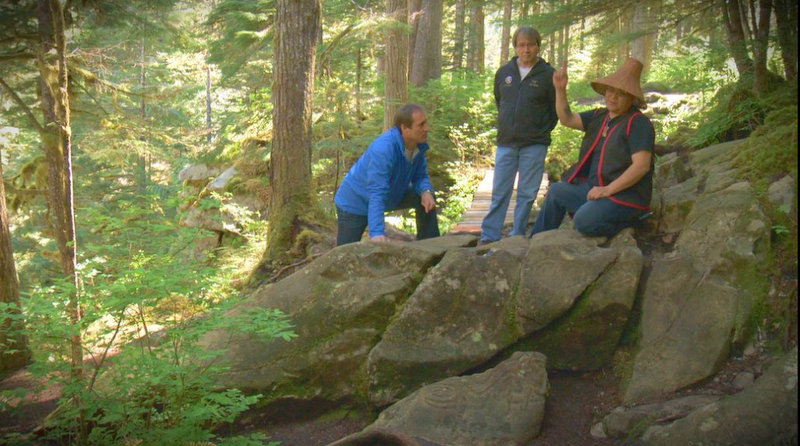BELLA COOLA – Chief Wally Webber stands on the ferry dock in Bella Coola and talks about the Nuxalk First Nation’s ambitious new project — a hotel and restaurant that they hope will become a hub for Aboriginal tourism in B.C.’s central coast.

Webber is excited by the prospect of bringing a much-needed economic boost to the region. But he admits to feeling a bit nervous about taking on such a big project.
“It’s our first run at it. It’s quite nerve-wracking,” said Webber, who is the Nuxalk’s elected and hereditary chief.
Part of those jitters come from the prospect of starting a new business. But part of it comes from the pressure to make sure that whatever he comes up with accurately reflects Nuxalk culture. He is interested in creating a viable business, but says he won’t risk selling out.
“Being Nuxalk, our culture is not for sale,” Webber said.
The quest for an authentic experience
Aboriginal tourism in B.C. is one of the fastest-growing sectors of the industry. Aboriginal Tourism Association of BC Director Brenda Baptiste says aboriginal tourism in the province brought in $50 million in revenue last year and that number is expected to grow to $68 million in 2017.
Baptiste says aboriginal tourism is a broad term that consists of “any kind of experience that is directly related to the identity of the nation that is presenting it or the entrepreneur that is presenting it.”
READ MORE: Ferry cuts to Bella Coola hurting tourism to Great Bear Rainforest: locals
In the case of the Nuxalk, they are developing a hotel styled after traditional big houses and a restaurant featuring local cuisine.
Elsewhere in Bella Coola, Copper Sun Gallery sells Nuxalk artwork and operates tours of local petroglyphs, totem poles and other historic sites.
“The most important part of the petroglyphs is telling our story of the Nuxalk, our history, where we’ve come from and where we are today,” says Copper Sun Gallery’s Chris Nelson.
WATCH: Taking a petroglyphs tour near Bella Coola

Baptiste says her organization aims to help B.C. First Nations find the right balance between commerce and culture to give travellers a truly “authentic” experience.
According to Baptiste, the idea of authenticity is a critical one to First Nations and tourists, saying one in four travellers “want some sort of aboriginal experience when they visit B.C.”
“To them it’s important that it’s authentic.”
Of course, defining a nebulous term like “authenticity” can be tricky. One person’s idea of an authentic experience can be another person’s idea of tacky kitsch.
Baptiste says the best way to settle the debate is to have each First Nation decide how best to present itself.
Why German tourists love the BC wilderness
“Aboriginal tourism is probably the greatest form of self-governance for individuals and communities because they decide what they want to share and they decide what they want to protect and they make decisions about how they want to showcase their culture and their beliefs and their identity,” she said.
“That’s the definition of authenticity.”
The search for authenticity can seem like a fool’s errand, but Baptiste says it generates discussion within First Nations that ultimately helps people better understand their past.
“Aboriginal cultural tourism requires that you understand who you are as an aboriginal person and that you understand your culture, and all of those values and principles that are part of that culture,” she said.
The Hill: The story behind one of BC’s most treacherous roads and the locals who built it
That dialogue can also help younger First Nations people better understand their history.
“The benefit goes back to the community by teaching young people about our culture, by revitalizing languages, revitalizing those cultural practices that may not have been around for a while,” Baptiste said.
Alix Goetzinger, who works as a cultural ambassador at the Haida Heritage Centre in Skidegate, agrees.
“I feel really empowered that I’m the one that’s gets to give them a positive view of not just of Haida people, but First Nations culture as a whole,” she said.
Nelson also finds value in sharing Nuxalk culture with the world.
He conducts tours of local petroglyphs that he estimates are around 7,000 years old. That would make them older than historic sites such as Egypt’s Pyramids of Giza and England’s Stonehenge, tourist attractions that attract millions of visitors each year. Nelson believes the Nuxalk petroglyphs have just as much historic significance as those famous sites and he wants to share them with the world.
The Nuxalk consider the petroglyphs to be a sacred site and Nelson consulted extensively with local elders and hereditary chiefs to make sure that the stories he shares on his tour properly reflect Nuxalk traditions. He hopes that by offering an intimate view of Nuxalk culture, he can create an experience that everyone in the world can relate to.
“I always like to explain that the petroglyphs tell the story of the earth, that it reminds us why we’re here, that we’re here to fulfill our lives and continue to grow each year — mentally, physically spiritually — and obtain knowledge from each other.
“That’s universal.”
– With files from Sophie Lui




Comments